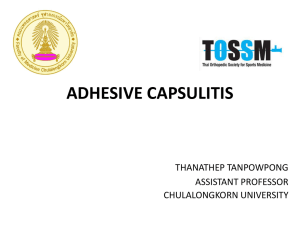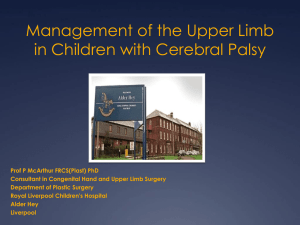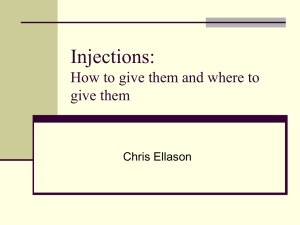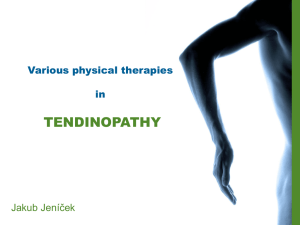Steroid Injection
advertisement
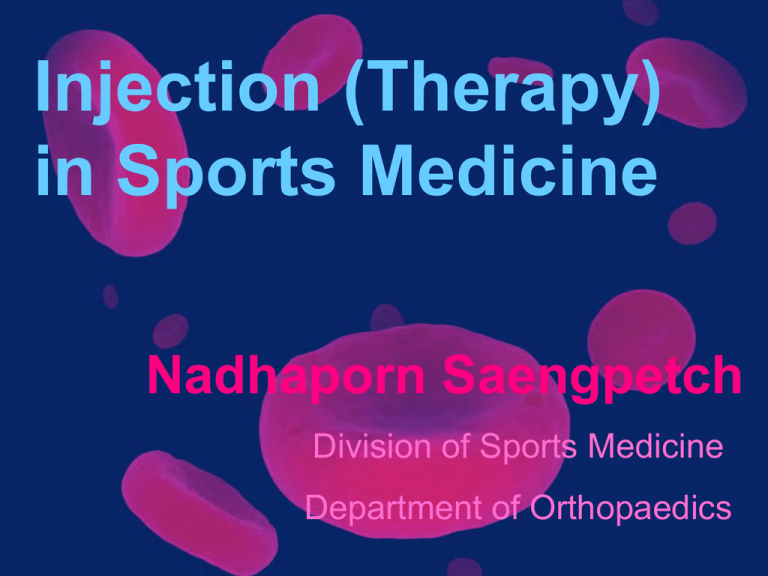
Injection (Therapy) in Sports Medicine Nadhaporn Saengpetch Division of Sports Medicine Department of Orthopaedics Steroid Injection Corticosteroid Injection • Lack of good quality research data to support the wide space use • Reduce tendon strength (not universal) • Tennis elbow: effective in short term (2-6 wks) (Hey EM BMJ 1999;319:964-8) • Report some higher recurrence rate than “wait and see” (Smidt N Lancet 2002;359:657-662) • 123 male Sprague-Dawley rats • Control, tendon injury, steroid injection and tendon injury with steroid injection • Single corticosteroid dose has significant short-term (transient) effects on the biomechanic properties of both injured and uninjured RCT (Mikolzyk DK J Bone Joint Surg Am 2009;91:1172-80) ISP Tendon • Single strands rat tail collagen fascicle • 1 mL methylprednisolone acetate 40 mg + 9% saline 0.5 mL VS 1 mL methylprednisolone acetate 40 mg + 9% saline 2 mL • Tensile strength markedly reduced after 3and 7-day incubation in both high and low concentration (Haraldsson BT Am J Sports Med 2006;34(12):1992-7) Ultimate stress in High/Low Conc. High(40) vs Low(10) Dose Improve pain 6 wks Improve sleep disturbance 6 wks Improve functional impairment 6 wks • Subacromial corticosteroid injection • To analyse type III to type I collagen expression ratio (Wei AS J Bone Joint Surg Am 2006;88(6):1331-8) Gene Expression on Collagen Type I/III Supraspinatus Tendinopathy • 2 studies show a small benefit at 4 weeks • Small numbers of subject (Buchbinder R Cochrane Database Syst Rev. 2003;1:CD004016) Shoulder Pain • No absolute distinction between acute and chronic pain • May reflect by ineffectiveness of initial intervention Causes of Shoulder Pain Pathology of Shoulder Pain • • • • • • • Osteoarthritis Rotator cuff tear Primary adhesive capsulitis Tendinitis (SSP, Biceps) Bursitis (SA-SD) Impingement syndrome Overlapping diagnosis or shoulder pain is the secondary cause of diseases Chronic Shoulder Pain Non-surgical Treatment Algorithm (Andrews JR Arthroscopy 2005;21(3):333-47) Intra-articular Steroid Injection • Better relief than oral NSAIDs • No enough evidence to refuse or support the benefit of steroid (Cochrane 2002) • Good for polymyalgia rheumatica • Adverse effects: dermal atrophy, bacterial arthritis, hemarthrosis and thrombophleblitis Bicipital Tendinitis • Local and steroid (1%Xylocaine and Triamcinolone 10 mg) • Bony landmark: bicipital groove • Target tissue: biceps sheath How to prove the RIGHT location? External rotate to show the better groove exposure Palpate the groove , then point the tip more superficial to the tendon Rotator Cuff Tendinitis • Partial cuff torn: pain and loss of the power • Tendinitis may be the presenting symptom • Stiff shoulder with loss of AER and concomittant with impingement signs • Should we prove the tendon integrity? If yes….how? ultrasound, CT scan and MRI • 58 pts • 5 mL of 2% xylocaine VS or 4 mL of 2% xylocaine and 1 mL (6 mg) of betamethasone • no more effective in improving the quality of life, range of motion, or impingement sign than xylocaine alone (Alvarez CM Am J Sports Med 2005;33(2): 225-62) WORCI • AIR, AER, AFE • Neer impingement tests • WORCI, ASES, DASH Effects of Steroid on Cuffs • Collagen fascicles • Biomechanic strength • Can mimic a rotator cuff tear (Borick JM Arthroscopy 2008;24(7): 846-9) • Methylprednisolone 0.6mg/kg subacromial injection • Type I and III Collagen expression 60 SpragueDawley rats Control Tendon injury Steroid Tendon Injury + Steroid Subacromial Methylprednisolone • A single dose corticosteroid does not alter the acute phase response of an injured rotator cuff tendon in the rat • same steroid dose in uninjured tendons initiates a short-term response equivalent to that of structural injury (Wei AS J Bone Joint Surg Am 2006;88(6): 1331-6) Hyaluronic Acid Injection What is hyaluronic acid? • A polysaccharide secreted into the joint space by type B synoviocytes or fibroblasts • Viscoelasticity for lubrication and chondroprotective effects • Anti-inflammatory properties, stimulate synovial fibroblasts to produce endogenous HA and decrease pain What is hyaluronic acid? • A long-chain biopolymer with repeated sequences of N-acetyl-glucosamine and glucuronic acid • Avian / bacterial origin • Hylan: cross-link molecules modified from HAs (to increase viscosity and clearance from the joint) Intra-articular Hyaluronans Injection • Safety profile, no adverse effect • Enhance endogenous hyaluronan synthesis, enhance biosynthesis and degradation of cartilage, inhibit inflammation, inhibit secondary pain mediators and direct coat nociceptors • Hyalgan (Sodium Hyaluronate) clarified its true usefulness (Andrews JR Arthroscopy 2005;21(3):333-47) How to choose the ‘right one’ for each patients • Who is fit to have the IA-HA injection? • The cost-effectiveness for the equivocal type of patients • How last long does it work in the joint? • The rheological properties and molecular weight of the hyaluronan preparations?? • Which joints that I should inject it? Who is proper to have IA-HA? • Old age < 65 yrs. • Early arthritis (Albach grade 1,2) without mechanical symptoms (Wang CT J Bone Joint Surg Am 2004;86A-3:538-45 Toh EM Knee 2002;9(4):321-30) • Inactive with household ambulation • Good expectation (Turajane T J Med Assoc Thai 2007;90(9):1845-52) Cost-effectiveness: Police General hospital • 183 pts.(208 knees) from 2001-2004 • A minimum of 2-year period follow up • drugs cost, hospitalization, resources • Non-response = proceed for TKA • Success group: 47,044.18 THB (12,240.41 THB) 63.26% • Failure group: 144,884 THB (9,324 THB) (Turajane T J Med Assoc Thai 2007;90(9):1839-44) How does it last long? • 1 day intra-articular sustaining • Variable onset of their efficacy • Hyalgan 26 wks, Hylan G-F20 52 wks (labeled) (Raman R The Knee (2008), doi:10.1016/j.knee.2008.02.012) • Inconclusive and controversial for the therapeutic efficacy (Adams ME Drug Safety 2000;23(2):115-30 Wobig M Clin Ther 1999;21:1549-62, Allard S Clin Ther 2000;22:792-5) • Need a well designed prospective RCT to resolve the uncertainty about magnitude of efficacy of various products • Hylan G-F 20 (Synvisc) (MW 6 x 106 Da.) vs Orthovisc (MW 1.55 x 106 Da.) • HMW HA produce an analgesic effect • The higher MW, the better the effect on the cartilage production • WOMAC physical function, stiffness scores and pain scores (patient & physician) • Improvement in physical function begin at the end of the 1st month lasted until 6 months. • No difference for stiffness scores, pain scores (Kotevoglu N Rheumatol Int 2006;26:325-30) Efficacy and safety of AI-HA or Hylan: RCT • 3 preparations in Switzerland (SVISCOT-1) a cross linked HMW hylan a non-cross-linked MMW HA of avian origin a non-cross-linked low LMW HA of bacterial origin • • • • 3 shots/cycle, N=660 pts WOMAC pain score at 6 months Local adverse events (flare/effusion), costs No difference in efficacy between hylan and HAs • Hylan had more local adverse events and higher cost ($1,459>$1,238>$1,017) (Jüni P Arthritis Rheumatism 2007;56(11):3610-19) Crosslink vs non-crosslink • Efficacy up to 1 yr in favor of cross-link HA (Torrence GW Osteoarthritis Cartilage 2002;10(7):518-27 Raynauld JP Osteoarthritis Cartilage 2002;10(7):506-17) Other support evidence • Higher viscosity and longer half-life increase long-term efficacy for duration and intensity of pain relief • Mechanism of pain relieve: directly inhibit nociceptors or binding substance P (Moreland LW Arthritis Res Ther 2003;5:285-9) • But mechanism to relief pain in OA knee remains under investigation Shoulder Adhesive capsulitis • Compared with intra-articular steroid injection • Should separate 1° frozen shoulder from post-traumatic • Hyaluronan show exponentially increasing osmotic pressure with increasing concentration (Laurent TC Ann Rheum Dis 1995;54:429) • HAs may restore a normal capsular hydrataction. • Absorb and desorb water molecules capacity of HA can inhibit in some way the fibrotic process (Rovetta G Tissue Reactions 1998;4:125-30) Glenohumeral OA Rheumatoid Arthritis both shoulder OA shoulder • The same idea for symptomatic OA knee • Outcome measures: VAS score, UCLA score, SST • Improved ADL and ability to sleep • Significantly improve mobility • Adverse events: local pain, swelling, flare • Main problem: correct space of injection • Shoulder OA, impingement, bursitis, tendinopathy and frozen shoulder • N=660, Hyalgan (3&5 shots and saline) • VAS score, shoulder motion • Presence of shoulder OA may be underappreciated in the setting of rotator cuff pathology • Shoulder OA demonstrated significantly better VAS after treatment than others. (Blaine T J Bone joint Surg Am 2008;90:970-9) Hip OA hip • No difference between steroid-HAsplacebo (saline) at the endpoint result • Some clinical improvement for pain and walking ability (Qvistgaard E Osteoarthritis Cartilage 2006;14:163-70) U/S guide Ankle OA ankle • Exposure of subchondral bone at a weightbearing site at which bone will be abraded and further damage • HAs: viscosupplement and biosupplement • 4 Meta-analyses: effect equivalent or greater than NSAIDs Listrat V Osteoarthritis Cartilage 1997;3:153-30 Lo GH JAMA 2003;209:3115-21 Arrich J CMAJ 2005;172:1039-43 Wang CT J Bone Joint Surg Am 2004;86:538-45 OA ankle Possible saline effects • Break scar apart • Slightly lubricate • Dilute the lytic enzymes and proinflammatory cytokines A double-blind RCT • Hyalgan 1 mL vs phospate-buffered saline 1 mL • N=17, 6 mo, ankle OA score pain and disability assessment, WOMAC, pts’ global assessment • Only significantly difference within-subject differences (p<0.0001) (Salk RS J Bone Joint Surg Am 2006;88(2):295-302) Injection Techniques Injection Techniques (Courtney P Best Practice Res 2005;19:345-69) Injection Techniques My practice: shoulder Shoulder: anterior approach My practice: knee Knee: medial approach Knee: superolateral approach Ankle: anterior approach EHL Tibialis anterior Complications • Acute psuedoseptic arthritis: a case report (Ostenil), onset = ? (Roos J Joint Bone Spine 2004;71:352-4) • Mostly reported with Hylan • None of cases occurred after the first injection, suggesting a role of sensitization to HA • Ostenil: LMW and contains no component of animal sources (Kurosaka N J Rheumatol 1999;26:2186-90) Complications • Septic Knee Arthritis: 2 case reports (Albert C Joint Bone Spine 2006;73:205-7) • S. aureus and N. Mucosa • Giving HA injection in a brief intervals is not recommended, pathogen inoculation • Previous glucocorticoid injections promotes the occurrence of infection • The rare pathogen often associates with an underlying immunodeficiency. (Lechowski L Ann Med Interne (Paris) 1995;146:592-3 Vigouroux C Presse Med 1992;21:1434-5) Extended clinical usage IA-HA after knee arthroscopy • A temporary synovial fluid substitute containing HA • Purpose: to remove the products of cartilage wear, inflammatory cells and molecules from the joint • Counter the onset of painful inflammatory phases • Have a negative effect on the metabolism and structure of the joint cartilage Intra-operative IA-HA injection for knee arthroscopic debridement • High dose of HMW HA (Orthovisc) single shot 6 mL/90 mg • standard recommendation 2 mL/amp x 3 shots weekly • N=23, ICRS Grade II or III lesion • WOMAC and SF-36 • POW 1, 3, 12, 24 (Li X J Orthop Surg Res 2008;43:1-8) Transected ACL from hind limbs of Wistar rats 1.0 mg of HA 800 kDa from rooster comb cartilage synovium Difference in joint width saline HA saline HA sham sham (Yen-Hsuan Jean J Orthop Res 2006;6:1052-60) Management of Tendinopathy normal Mild tendinosis Severe tendinosis Tendinopathy • A generic description of the clinical conditions • Pain and pathologic changes in and around the tendons arising from overuse Tendinopathy • Show either absent or minimal inflammation • Hypercellularity • A loss of the tight bundled collagen appearance • Increase in proteoglycan content • Neovascularization • “Failed healing response” Tendinosis • The histologic description • A degenerative pathologic condition with a lack of inflammatory change Tendinitis • An inflammatory process • It may play a role in the initiation, but not the propagation and progression of the disease process Enthesis • Tendon insertion or osteotendinous junction • Recognized as a site of pathologic changes in many common athletic injuries • Tendo achilles, patellar, rotator cuff, forearm extensor and thigh adductor Achilles Tendinitis • 3 distinct regions • Toe, linear and partial failure before it failed (Rees JD Rheumatology 2006;45:508-521) Eccentric exercise of TA New Trends Autogenous Red Cells Injection • Poor quality studies elbow (Edward SG J Hand Surg (Am) 2003:28:272-8) (Suresh SP Br J Sports Med 2006;40:935-9) Patellar tendinopathy (James SL Br J Sports Med 2007:41:518-21) • Medial epicondylopathy: may improve without any intervention • Required better study design Sclerosant Injection • Ultrasound-guided • Decrease pain and neovascularization • TA, tennis elbow and shoulder impingement (Ohberg L Knee Surg Sports Traumatol Arthrosc 2003;11:339-343) (Zeisig E Knee Surg Sports Traumatol Arthrosc 2006;13:1218-24) (Alfredson H Knee Surg Sports Traumatol Arthrosc 2006;14:1321-6) • Nitric oxide (vasodilator), has an opposite effect of sclerosant injection Thank you
